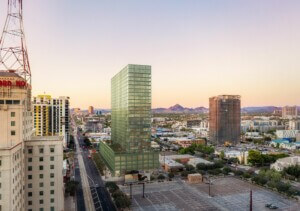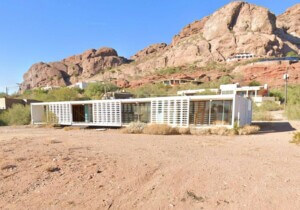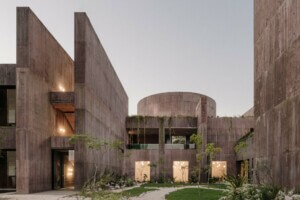Good afternoon and welcome back to another roundup of the art, architecture, and technology news you need to know.
Here’s what’s going on today:
A Harambe statue appeared across from Wall Street’s Charging Bull
Goodbye Fearless Girl, hello Harambe. Morning commuters and tourists passing through the Financial District in Manhattan yesterday found a seven-foot-tall bronze recreation of the deceased gorilla staring down the iconic Charging Bull, which had been buried in 10,000 bananas. Harambe was fatally shot by zookeepers in 2016 after a child fell into his enclosure at the Cincinnati Zoo, and the memes proliferated online ever since (for some reason). Sapien.Network, the fledgling social networking platform behind the stunt, claims that the installation is about the country’s ever-widening income inequality and the divide between haves and have-nots.
H/t to NBC New York
The Global Cement and Concrete Association pledge to hit net-zero by 2050
The lead-up to the COP26 climate conference on October 31 continues, as the Global Cement and Concrete Association has pledged to hit net-zero carbon emissions by 2050 and reduce its current carbon output 25 percent by 2030. The association is made up of 40 concrete and cement manufacturers, representing a full 80 percent of the industry outside of China. Along with planning to build 10 industrial carbon-capture plants by 2030 (a technology that has never been deployed in real-world applications at that scale), the industry is researching low-carbon alternatives to the high-carbon clinker used as the main ingredient in Portland cement.
H/t to Dezeen
New York City subway ridership is creeping up again, tops 3.2 million daily riders
Although still a 46 percent drop from its pre-pandemic average, the New York City subway system saw 3.2 million riders on October 14, a high mark since the city went into shutdown mode on March 13 of last year. That’s more than ten times what it was at the system’s lowest point, when only 300,000 daily riders took the subway in April of 2020, but the MTA still has a long way to go to make up its current revenue gap.
H/t to 6sqft
Mass protests spread across Puerto Rico as the electricity grid falters
Soaring prices, micro surges, frequent blackouts, and faltering reliability across all of Puerto Rico’s electrical grid has spurred mass protests against the island’s new private energy provider, LUMA Energy. Spoiled food and medication, ventilator failures, and critical equipment outages have plagued Puerto Rico’s 1.5 million residents for months and the situation is only getting worse. This all comes after it was promised that LUMA’s replacement of the public Puerto Rico Electric Power Authority would bring stability to a system plagued by lingering hurricane damage, but LUMA’s reported inexperience and mass departures by former Power Authority employees after being forced to reapply for their old jobs have ground improvements to a halt. Puerto Rico’s electrical grid is frequently ranked the worst in the United States.
H/t to the New York Times
Chris Cornelius is now the only Indigenous architecture department chair in the U.S.
Chris Cornelius, an architect and founder of studio:indigenous, has been tapped to chair the Department of Architecture at The University of New Mexico School of Architecture and Planning (SA+P). Cornelius is a citizen of the Oneida Nation of Wisconsin, making him the first Indigenous chair of an architecture program in the U.S. Prior to his appointment at the SA+P, Cornelius had been a faculty member at the Department of Architecture at the University of Wisconsin-Milwaukee since 2004. He succeeds Kuppaswamy Iyengar, who had held the position since 2014.
“We’re thrilled to have Chris Cornelius, who brings exemplary experience in design pedagogy and architectural design, as well as expertise in the study of contemporary Indigenous architectural representations. He is a leading voice in critical debates now taking place on the decolonization of architectural pedagogy,” said Robert Alexander González, dean of SA+P, in the announcemen. “We’re grateful to Professor Iyengar for his able leadership as acting chair and to Professor Quale for his many years of dedication and contributions to the department.”
Cornelius will officially join UNM effective November 1 of this year.
Phoenix is finally rethinking its response to extreme heat
Phoenix is one of, if not the, hottest cities in America, with a record 143 days of triple-digit temperatures in 2020. Now, the Arizonan city has launched an Office of Heat Response & Mitigation, with climate and health scientist David Hondula as its lead, to help protect residents from the life-threatening heat. Construction Dive has interviewed Hondula on his plans for cooling Phoenix, which range from mitigating the urban heat island effect to rolling out more shade and water opportunities.
H/t to Construction Dive











